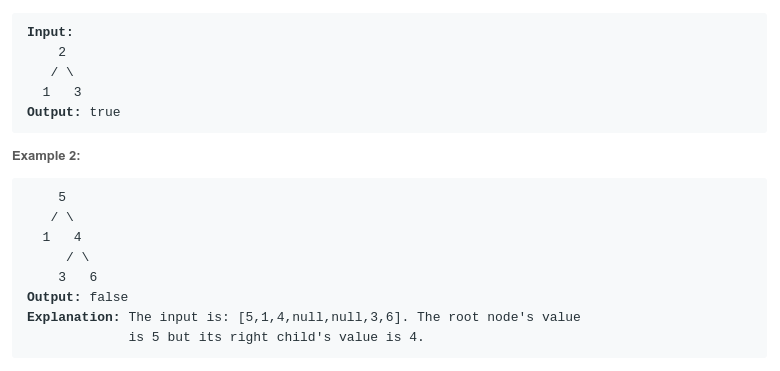Question
Given a binary tree, determine if it is a valid binary search tree (BST).
Assume a BST is defined as follows:
- The left subtree of a node contains only nodes with keys less than the node's key.
- The right subtree of a node contains only nodes with keys greater than the node's key.
- Both the left and right subtrees must also be binary search trees.
Example 1:

Difficulty:Medium
Category:Tree, Depth-First-Search
Solution
Note: in order to cover the range of -2^31 ~ 2^31-1, we need to use long or nullable integer.
Time complexity: O(n) Space complexity: O(n)
class Solution {
public:
bool isValidBST(TreeNode* root) {
long pre = LONG_MIN;
return inorder(root, pre);
}
private:
bool inorder(TreeNode* root, long& pre) {
if (!root) return true;
bool left = inorder(root->left, pre);
// Deal with root->val
if (root->val <= pre)
return false;
else
pre = root->val;
bool right = inorder(root->right, pre);
return left && right;
}
};
Follow up
如果限制不能使用 long 的数据类型的话, 我们可以考虑使用 TreeNode*.
Traverse the tree and limit the range of each subtree and check whether root’s value is in the range.
Time complexity: O(n) Space complexity: O(n)
class Solution {
public:
bool isValidBST(TreeNode* root) {
return isValidBST(root, nullptr, nullptr);
}
private:
bool isValidBST(TreeNode* root, int* min_val, int* max_val) {
if (!root) return true;
if ((min_val && root->val <= *min_val) || (max_val && root->val >= *max_val)) return false;
return isValidBST(root->left, min_val, &root->val) && isValidBST(root->right, &root->val, max_val);
}
};